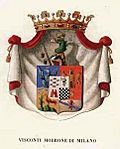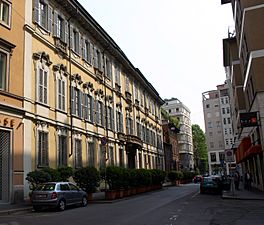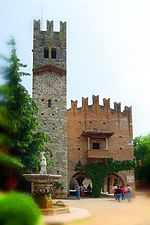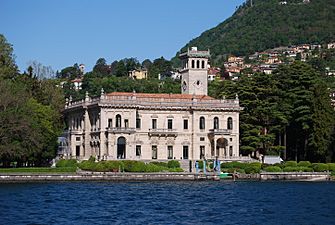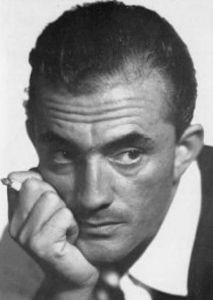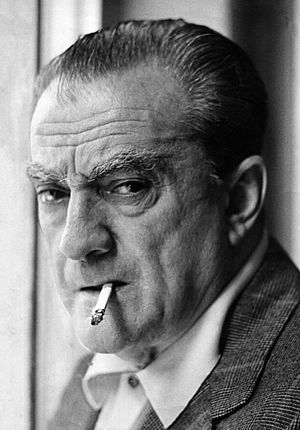Luchino Visconti facts for kids
Quick facts for kids
Luchino Visconti
|
|
|---|---|
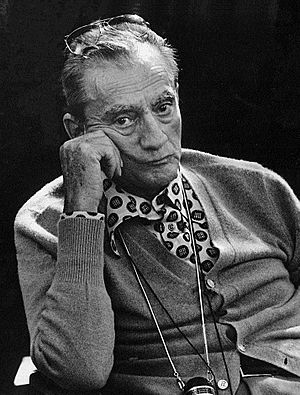
Visconti in 1972
|
|
| Born |
Luchino Visconti di Modrone
2 November 1906 |
| Died | 17 March 1976 (aged 69) |
| Occupation |
|
|
Notable work
|
|
| Title | Conte di Lonate Pozzolo |
| Relatives | Eriprando Visconti (nephew) |
| Family | Visconti di Modrone |
| Honours | |
Luchino Visconti di Modrone (born November 2, 1906 – died March 17, 1976) was a famous Italian film director, stage director, and screenwriter. He was a very important person in Italian art and culture during the mid-1900s.
Visconti was one of the creators of a film style called cinematic neorealism. This style focused on showing real-life stories. Later, he started making grand, beautiful movies that explored ideas like beauty, change, and European history. Many of his films looked at how noble and wealthy families changed over time.
He won many awards, including the Palme d'Or and the Golden Lion. His movies are still seen as very important and have influenced many filmmakers who came after him.
Born into a noble family in Milan, Visconti loved art from a young age. He started his career helping director Jean Renoir. His first movie, Ossessione (1943), was about working-class people facing tough challenges. The Fascist government didn't like it, but today it's seen as a groundbreaking film in Italian cinema.
Some of his most famous films include Senso (1954) and The Leopard (1963), which were historical dramas based on famous Italian books. He also made the intense drama Rocco and His Brothers (1960) and his "German Trilogy": The Damned (1969), Death in Venice (1971), and Ludwig (1973). Besides films, he was also a talented director for plays and operas in Italy and other countries.
Contents
Early Life and Artistic Beginnings
Luchino Visconti was born into a well-known noble family in Milan. He was one of seven children. His father was Giuseppe Visconti di Modrone, a Duke and Count. His mother, Carla Erba, came from a wealthy family that owned a pharmaceutical company. Luchino was known as Count Luchino Visconti di Modrone. His family was a branch of the Visconti of Milan, who ruled Milan from 1277 to 1447.
He grew up in his family's grand home, the Palazzo Visconti di Modrone in Milan. He also spent time at their country estate, Grazzano Visconti Castle. When his parents separated in the early 1920s, he moved with his mother to her house in Milan and her summer home, Villa Erba, on Lake Como. He later inherited his father's villa in Rome, where he lived for many years.
From a young age, Luchino was surrounded by art, music, and theater. His family's Milan palace had its own small private theater where the children performed. They also had a special box at the famous La Scala opera house. Luchino learned to play the cello and met famous artists like composer Giacomo Puccini and conductor Arturo Toscanini. He loved reading, especially the book In Search of Lost Time by Proust, which he hoped to turn into a film one day. Before becoming a filmmaker, he was very keen on training racehorses.
Fighting for Freedom: Wartime Activities
During World War II, Visconti joined the Italian Communist Party. He believed this group was the best way to fight against the Fascist government led by Benito Mussolini. At first, he had been impressed by the look of the Fascist parades, but he soon grew to hate Mussolini's rule. He felt that the wealthy people had betrayed their country by supporting the harsh government.
After the king left Italy in 1943 and the Germans took control, Visconti began working with the Italian resistance. He bravely helped communist fighters, even though it was very dangerous. His home in Rome became a secret meeting place for artists who opposed the government.
He even went into hiding in the mountains, using a fake name. Visconti helped English and American prisoners of war who had escaped. He also gave shelter to resistance fighters in his Rome house, with help from actress María Denis.
In April 1944, after the Germans occupied Rome, Visconti was arrested. He was held by a cruel anti-resistance leader and sentenced to be executed. Luckily, María Denis stepped in at the last moment and saved his life. After the war, Visconti gave evidence against his captor, who was later punished.
Filmmaking Career
Early Films and Neorealism
Visconti started his film career working on the sets of Jean Renoir's movie Partie de campagne (1936). He got this job thanks to their shared friend, Coco Chanel. After a short trip to Hollywood in the United States, he returned to Italy to assist Renoir again on Tosca (1941).
With other writers from a Milanese film magazine, Visconti wrote the script for his first movie as a director: Ossessione (Obsession, 1943). This film was one of the very first neorealist movies. It was an unofficial adaptation of the book The Postman Always Rings Twice.
When Ossessione first showed at a film festival, Mussolini's son, Vittorio, who was in charge of cinema, was very angry. He reportedly walked out, saying, "This is not Italy!" The Fascist government then tried to stop the film from being shown. It wasn't publicly seen in Rome until May 1945, after the war.
In 1948, Visconti wrote and directed La terra trema (The Earth Trembles). This movie was based on a novel and continued his neorealist style.
Moving Beyond Neorealism
Visconti kept making films in the 1950s, but he started to move away from strict neorealism. His 1954 film, Senso, was shot in color. It was set in Venice in 1866, when the city was under Austrian control. In this movie, Visconti mixed real-life details with romantic feelings, which was a new direction for him.
He returned to neorealism one more time with Rocco e i suoi fratelli (Rocco and His Brothers, 1960). This powerful story was about a family from Southern Italy who moved to Milan hoping to find a better life. In 1961, he was part of the jury at the 2nd Moscow International Film Festival.
Later, More Personal Films
Throughout the 1960s, Visconti's films became more personal and grand. Il Gattopardo (The Leopard, 1963) was based on a famous book about the decline of a noble Sicilian family during the Risorgimento (the time when Italy became a united country). The film shows how times were changing through its characters. The old prince, played by Burt Lancaster, is kind but traditional. A new, clever businessman from the village, played by Paolo Stoppa, seems humble but is actually very cunning. The story shows the tension as the old ways fade and a new Italy rises. The American version of this film had important scenes cut, which Visconti did not approve of.
In 1969, Visconti's film The Damned earned him a nomination for an Academy Award for Best Original Screenplay. This well-known film is about a wealthy German industrial family that falls apart as the Nazis gain power in the 1930s. The film's rich beauty and focus on decline are typical of Visconti's style. This style is also very clear in his movie Death in Venice (1971), which was based on a famous book by Thomas Mann.
Theatre and Opera Direction
Visconti was also a highly respected director for plays and operas. From 1946 to 1960, he directed many performances for the Rina Morelli-Paolo Stoppa Company, often working with actor Vittorio Gassman. He also directed many famous opera productions.
His love for opera is clear in his 1954 film Senso, which starts with scenes from an opera filmed at the Teatro La Fenice in Venice. His opera career began in December 1954 when he directed La vestale at Milan's Teatro alla Scala. He also directed a very famous revival of La traviata at La Scala in 1955, starring the legendary singer Maria Callas. Another famous production was Anna Bolena (also at La Scala) in 1957, also with Callas.
In 1958, he directed a significant production of Verdi's Don Carlos at the Royal Opera House in London. He also directed Macbeth in Spoleto in 1958 and a famous black-and-white Il trovatore at the Royal Opera House in 1964. In 1966, Visconti's beautiful production of Falstaff for the Vienna State Opera, conducted by Leonard Bernstein, was highly praised. However, his simple 1969 production of Simon Boccanegra with unusual costumes caused some debate.
Filmmaking Style and Ideas
After World War II, Visconti became one of the key figures in the Italian neorealist film movement. This movement focused on showing the difficult economic and social conditions of the time, and how they affected ordinary people. Even though Visconti came from a wealthy, educated noble family and never lacked money, his films often showed this tension between different social classes. He once said he felt like he belonged to an older world, from the 1800s.
In his film The Leopard, he explored the decline of an old social order and the arrival of "modern times." He didn't see his grand, historical scenes as an escape into imaginary worlds. Instead, he saw them as a way to understand important historical changes that would only become clear later. He looked for great books that showed the differences between generations and their ways of seeing the world. He believed this was part of being realistic in art. When some people called his work "decadent," he referred to Thomas Mann, another artist who created art in a similar way.
Later Life and Passing
Visconti smoked a lot of cigarettes. In 1972, he suffered a serious stroke, but he continued to smoke heavily. He passed away in Rome from another stroke on March 17, 1976, at the age of sixty-nine. There is a museum dedicated to his work in Ischia, where he had his summer home.
Work
Filmography
Feature films
| Year | Original title | International English title | Awards |
|---|---|---|---|
| 1943 | Ossessione | Obsession | |
| 1948 | La terra trema | The Earth Will Tremble | Special International Award — 9th Venice International Film Festival Nominated – Grand International Prize of Venice — 9th Venice International Film Festival |
| 1951 | Bellissima | Bellissima | |
| 1954 | Senso | Senso | Nominated – Golden Lion — 15th Venice International Film Festival |
| 1957 | Le notti bianche | White Nights | Silver Lion Prize – 18th Venice International Film Festival Nominated – Golden Lion — 18th Venice International Film Festival |
| 1960 | Rocco e i suoi fratelli | Rocco and His Brothers | Special Prize – 21st Venice International Film Festival FIPRESCI Prize – 21st Venice International Film Festival 1961 Nastro d'Argento for Best Director 1961 Nastro d'Argento for Screenplay Nominated – Golden Lion — 21st Venice International Film Festival |
| 1963 | Il gattopardo | The Leopard | Palme d'Or – 1963 Cannes Film Festival |
| 1965 | Vaghe stelle dell'Orsa | Sandra | Golden Lion — 26th Venice International Film Festival |
| 1967 | Lo straniero | The Stranger | Nominated – Golden Lion — 28th Venice International Film Festival |
| 1969 | La caduta degli dei | The Damned | 1970 Nastro d'Argento for Best Director Nominated – Academy Award for Best Original Screenplay — 42nd Academy Awards |
| 1971 | Morte a Venezia | Death in Venice | 25th Anniversary Prize — 1971 Cannes Film Festival David di Donatello for Best Director — 16th David di Donatello Awards 1972 Nastro d'Argento for Best Director Nominated — Palme d'Or — 1971 Cannes Film Festival Nominated — BAFTA Award for Best Film — 25th British Academy Film Awards Nominated — BAFTA Award for Best Direction — 25th British Academy Film Awards |
| 1973 | Ludwig | Ludwig | David di Donatello for Best Director — 18th David di Donatello Awards |
| 1974 | Gruppo di famiglia in un interno | Conversation Piece | 1975 Nastro d'Argento for Best Director |
| 1976 | L'innocente | The Innocent |
Other films
- Giorni di gloria, documentary, 1945
- Appunti su un fatto di cronaca, short film, 1951
- Siamo donne (We, the Women), 1953, episode Anna Magnani
- Boccaccio '70, 1962, based on the episode Il lavoro in Boccaccio's Decameron
- Le streghe (The Witches), 1967, episode La strega bruciata viva
- Alla ricerca di Tadzio, TV movie, 1970
Opera Productions Directed
| Year | Title and Composer | Opera House | Principal cast / Conductor |
|---|---|---|---|
| 1954 | La vestale, Gaspare Spontini |
La Scala | Maria Callas, Franco Corelli, Ebe Stignani, Nicola Zaccaria Conducted by Antonino Votto |
| 1955 | La sonnambula, Vincenzo Bellini, |
La Scala | Maria Callas, Cesare Valletti, Giuseppe Modesti Conducted by Leonard Bernstein |
| 1955 | La traviata, Giuseppe Verdi |
La Scala | Maria Callas, Giuseppe Di Stefano, Ettore Bastianini Conducted by Carlo Maria Giulini |
| 1957 | Anna Bolena, Gaetano Donizetti |
La Scala | Maria Callas, Giulietta Simionato, Nicola Rossi-Lemeni Conducted by Gianandrea Gavazzeni |
| 1957 | Iphigénie en Tauride, Christoph Willibald Gluck |
La Scala | Maria Callas, Franceso Albanese, Anselmo Colzani, Fiorenza Cossotto Conducted by Nino Sanzogno |
| 1958 | Don Carlo, Verdi | Royal Opera House, London |
Jon Vickers, Tito Gobbi, Boris Christoff, Gré Brouwstijn Conducted by Carlo Maria Giulini |
| 1958 | Macbeth, Verdi | Spoleto Festival | William Chapman & Dino Dondi; Ferruccio Mazzoli & Ugo Trama;Shakeh Vartenissian. Conducted by Thomas Schippers |
| 1959 | Il duca d'Alba, Donizetti | Spoleto Festival | Luigi Quilico, Wladimiro Ganzarolli, Franco Ventriglia, Renato Cioni, Ivana Tosini. Conductor: Thomas Schippers |
| 1961 | Salome, Richard Strauss | Spoleto Festival | George Shirley, Lili Chookasian, Margarei Tynes, Robert Anderson, Paul Arnold. Conductor: Thomas Schippers |
| 1963 | Il diavolo in giardino, Franco Mannino (1963) |
Teatro Massimo, Palermo | Ugo Benelli, Clara Petrella, Gianna Galli, Antonio Annaloro, Antonio Boyer. Conductor: Enrico Medioli. Libretto: Visconti & Filippo Sanjust |
| 1963 | La traviata, Verdi | Spoleto Festival | Franca Fabbri, Franco Bonisolli, Mario Basiola Conducted by Robert La Marchina |
| 1964 | Le nozze di Figaro, Wolfgang Amadeus Mozart |
Teatro dell'Opera di Roma | Rolando Panerai, Uva Ligabue, Ugo Trama, Martella Adani, Stefania Malagù. Conductor: Carlo Maria Giulini |
| 1964 | Il trovatore | Bolshoi Opera, Moscow (September) | Pietro Cappuccilli, Gabriella Tucci, Giulietta Simionato, Carlo Bergonzi Conducted by Gianandrea Gavazzeni |
| 1964 | Il trovatore, Verdi | Royal Opera House, London (November) (Sanjust production) |
Peter Glossop, Gwyneth Jones & Leontyne Price, Giulietta Simionato, Bruno Prevedi Conducted by Carlo Maria Giulini |
| 1965 | Don Carlo, Verdi | Teatro dell'Opera di Roma | Cesare Siepi, Gianfranco Cecchele, Kostas Paskalis, Martti Talvela, Suzanne Sarroca, Mirella Boyer. Conducted by Carlo Maria Giulini. |
| 1966 | Falstaff, Verdi | Vienna Staatsoper | Dietrich Fischer-Dieskau, Rolando Panerai, Murray Dickie, Erich Kunz, Ilva Ligabue, Regina Resnik. Conducted by Leonard Bernstein |
| 1966 | Der Rosenkavalier, Strauss | Royal Opera House, London | Sena Jurinac, Josephine Veasey, Michael Langdon. Conductor: Georg Solti |
| 1967 | La traviata, Verdi | Royal Opera House, London | Mirella Freni, Renato Cioni, Piero Cappuccilli. Conducted by Carlo Maria Giulini |
| 1969 | Simon Boccanegra, Verdi | Vienna Staatsoper | Eberhard Wächter, Nicolai Ghiaurov, Gundula Janowitz, Carlo Cossutta Conducted by Josef Krips |
| 1973 | Manon Lescaut, Giacomo Puccini |
Spoleto Festival | Nancy Shade, Harry Theyard, Angelo Romero, Carlo Del Bosco. Conductor: Thomas Schippers. |
See also
 In Spanish: Luchino Visconti para niños
In Spanish: Luchino Visconti para niños


